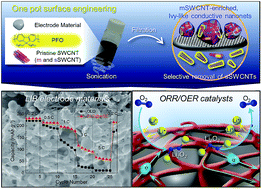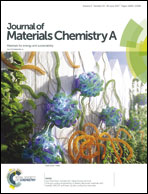One-pot surface engineering of battery electrode materials with metallic SWCNT-enriched, ivy-like conductive nanonets†
Abstract
A longstanding challenge facing energy conversion/storage materials is their low electrical conductivity, which often results in unwanted sluggish electrochemical reactions. Here, we demonstrate a new class of one-pot surface engineering strategy based on metallic single-walled carbon nanotube (mSWCNT)-enriched, ivy-like conductive nanonets (mSC nanonets). The mSC nanonets are formed on the surface of electrode materials through a poly(9,9-di-n-octylfluorenyl-2,7-diyl) (PFO)-assisted sonication/filtration process. PFO is known as a dispersant for SWCNTs that shows a higher affinity for semiconducting SWCNTs (sSWCNTs) than for mSWCNTs. Driven by this preferential affinity of PFO, sSWCNTs are separated from mSWCNTs in the form of sSWCNT/PFO hybrids, and the resulting enriched mSWCNTs are uniformly deposited on electrode materials in the form of ivy-like nanonets. Various electrode materials, including lithium-ion battery cathodes/anodes and perovskite catalysts, are chosen to explore the feasibility of the proposed concept. Due to their ivy-like conductive network, the mSC nanonets increase the electronic conductivity of the electrode materials without hindering their ionic transport, eventually enabling significant improvements in their redox reaction rates, charge/discharge cyclability, and bifunctional electrocatalytic activities. These exceptional physicochemical advantages of the mSC nanonets, in conjunction with the simplicity/versatility of the one-pot surface engineering process, offer a new and facile route to develop advanced electrode materials with faster electrochemical reaction kinetics.



 Please wait while we load your content...
Please wait while we load your content...